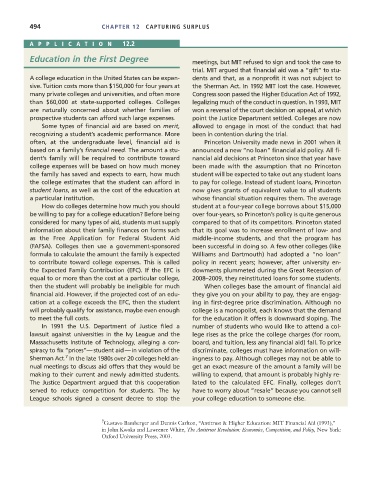Page 520 - Microeconomics, Fourth Edition
P. 520
c12capturingsurplus.qxd 8/17/10 8:24 PM Page 494
494 CHAPTER 12 CAPTURING SURPLUS
APPLICA TION 12.2
Education in the First Degree meetings, but MIT refused to sign and took the case to
trial. MIT argued that financial aid was a “gift” to stu-
A college education in the United States can be expen- dents and that, as a nonprofit it was not subject to
sive. Tuition costs more than $150,000 for four years at the Sherman Act. In 1992 MIT lost the case. However,
many private colleges and universities, and often more Congress soon passed the Higher Education Act of 1992,
than $60,000 at state-supported colleges. Colleges legalizing much of the conduct in question. In 1993, MIT
are naturally concerned about whether families of won a reversal of the court decision on appeal, at which
prospective students can afford such large expenses. point the Justice Department settled. Colleges are now
Some types of financial aid are based on merit, allowed to engage in most of the conduct that had
recognizing a student’s academic performance. More been in contention during the trial.
often, at the undergraduate level, financial aid is Princeton University made news in 2001 when it
based on a family’s financial need. The amount a stu- announced a new “no loan” financial aid policy. All fi-
dent’s family will be required to contribute toward nancial aid decisions at Princeton since that year have
college expenses will be based on how much money been made with the assumption that no Princeton
the family has saved and expects to earn, how much student will be expected to take out any student loans
the college estimates that the student can afford in to pay for college. Instead of student loans, Princeton
student loans, as well as the cost of the education at now gives grants of equivalent value to all students
a particular institution. whose financial situation requires them. The average
How do colleges determine how much you should student at a four-year college borrows about $15,000
be willing to pay for a college education? Before being over four-years, so Princeton’s policy is quite generous
considered for many types of aid, students must supply compared to that of its competitors. Princeton stated
information about their family finances on forms such that its goal was to increase enrollment of low- and
as the Free Application for Federal Student Aid middle-income students, and that the program has
(FAFSA). Colleges then use a government-sponsored been successful in doing so. A few other colleges (like
formula to calculate the amount the family is expected Williams and Dartmouth) had adopted a “no loan”
to contribute toward college expenses. This is called policy in recent years; however, after university en-
the Expected Family Contribution (EFC). If the EFC is dowments plummeted during the Great Recession of
equal to or more than the cost at a particular college, 2008–2009, they reinstituted loans for some students.
then the student will probably be ineligible for much When colleges base the amount of financial aid
financial aid. However, if the projected cost of an edu- they give you on your ability to pay, they are engag-
cation at a college exceeds the EFC, then the student ing in first-degree price discrimination. Although no
will probably qualify for assistance, maybe even enough college is a monopolist, each knows that the demand
to meet the full costs. for the education it offers is downward sloping. The
In 1991 the U.S. Department of Justice filed a number of students who would like to attend a col-
lawsuit against universities in the Ivy League and the lege rises as the price the college charges (for room,
Massachusetts Institute of Technology, alleging a con- board, and tuition, less any financial aid) fall. To price
spiracy to fix “prices”—student aid—in violation of the discriminate, colleges must have information on will-
7
Sherman Act. In the late 1980s over 20 colleges held an- ingness to pay. Although colleges may not be able to
nual meetings to discuss aid offers that they would be get an exact measure of the amount a family will be
making to their current and newly admitted students. willing to expend, that amount is probably highly re-
The Justice Department argued that this cooperation lated to the calculated EFC. Finally, colleges don’t
served to reduce competition for students. The Ivy have to worry about “resale” because you cannot sell
League schools signed a consent decree to stop the your college education to someone else.
7 Gustavo Bamberger and Dennis Carlton, “Antitrust & Higher Education: MIT Financial Aid (1993),”
in John Kwoka and Lawrence White, The Antitrust Revolution: Economics, Competition, and Policy, New York:
Oxford University Press, 2003.

